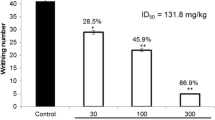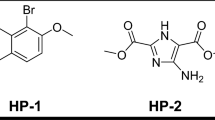Abstract
Current study was designed to explore the analgesic and the anti-inflammatory activities of a new cucurbitacin isolated from Tunisian Citrullus colocynthis Schrad. seeds. 11-Deoxocucurbitacin-I-2-O-β-d-glucoside was isolated from C. colocynthis seed chloroform fraction. This organic fraction, one of its subfraction (F19), and the purified 11-deoxocucurbitacin-I-2-O-β-d-glucoside were investigated for anti-inflammatory activity using carrageenan-induced paw edema assay in rats at the doses of 0.5 and 1 mg/kg body wt for the chloroform fraction and of 0.1 and 0.5 mg/kg body wt for the F19 subfraction and the purified product. For analgesic activity of different samples, the acetic acid and the phenylbenzoquinone writhing tests in mice were used at doses of 0.05, 0.1, and 0.5 mg/kg body wt. The results revealed that the seed chloroform fraction, the F19 subfraction, and the 11-deoxocucurbitacin-I-2-O-β-d-glucoside exerted significant in vivo anti-inflammatory and analgesic activities at all tested doses.These results suggest that 11-deoxocucurbitacin-I-2-O-β-d-glucoside from C. colocynthis seeds possessed potential pharmacological values and could be further investigated for its design as a new lead compound for management of pain and inflammation.

Similar content being viewed by others
References
Al-Gaithi F, El-Diri MR, Adeghate E, Amiri MH (2004) Biochemical effects of Citrullus colocynthis in normal and diabetic rats. Mol Cell Biochem 261:143–149
Ashok AA, Thoma OM, Ching-jer Chang JA, Saenz R, John M (1985) A cytotoxic deoxocucurbitacin from Desfontainia spinosa. Phytochemistry 24:1803–1805
Bendjeddou D, Lalaoui K, Satta D (2003) Immunostimulating activity of the hot water soluble polysaccharide extracts of Anacyclus pyrethrum, Alpinia galangal and Citrullus colocynthis. J Ethnopharmacol 88:155–160
Brito ARMS, Antonia MA (1998) Oral anti-inflammatory and antiulcerogenic activities of a hydroalcoholic extract and partitioned fractions of Turnera ulmifolia (Turneraceae). J Ethnopharmacol 61:215–228
Brooks RR, Carpenter JF, Jones SM, Ziegler TC, Pong SF (1991) Canine carrageenin induced acute paw inflammation model and its response to nonsteroidal antiinflammatory drugs. J Pharmacol Methods 25:275–283
Burch RM, DeHaas CH (1990) A bradykinin antagonist inhibits carrageenan edema in rats. Naunyn Schmiedebergs Arch Pharmacol 342:189–193
Emery P, Salmon M (1991) The immune response. 2. Systemic mediators of inflammation. Br J Hosp Med 45:164–168
Gebhardt R (2003) Antioxidative, antiproliferative and biochemical effects in Hep G2 cells of a homeopathic remedy and its constituent plant tinctures tested separately or in combination. Arzneimittelforschung 53:823–830
Gupta MUK, Mazumder P, Gomathi ThamilSV (2006) Anti-inflammatory evaluation of leaves of Plumeria acuminate. BMC Complement Altern Med 6:1472–1475
Koster R, Anderson M, De Beer EJ (1959) Acetic acid for analgesic screening. Fed Proc 18:418–420
Le Flock E (1983) Contribution à une étude Ethnobotanique de la flore tunisienne. Ed. Imprimerie officielle de la république tunisienne, Tunis, pp. 241–244
Boukef MK (1986) Médecine traditionnelle et pharmacopée. Les plantes dans la médecine traditionnelle tunisienne. Ed. Agence de coopération culturelle et technique, Paris, p 165
Marzouk B, Marzouk Z, Décor R, Edziri H, Haloui E, Fenina N, Aouni M (2009) Antibacterial and anticandidal screening of Tunisian Citrullus colocynthis Schrad. from Medenine. J Ethnopharmacol 125:344–349
Marzouk B, Marzouk Z, Décor R, Mhadhbi L, Fenina N, Aouni M (2010a) Antibacterial and anticandidal activities of several populations of Tunisian Citrullus colocynthis Schrad. immature fruits and seeds. J Med Mycol 20:179–184
Marzouk Z, Marzouk B, Mahjoub MA, Haloui E, Zine M, Aouni M, Fenina N (2010b) Screening of the antioxidant and the free radical scavenging potential of Tunisian Citrullus colocynthis Schrad. from Mednine. J Food Agric Environ 8:161–165
Marzouk B, Marzouk Z, Haloui E, Fenina N, Bouraoui A, Mahjoub A (2010c) Screening of analgesic and anti-inflammatory activities of Citrullus colocynthis from southern Tunisia. J Ethnopharmacol 128:15–19
Penn GB, Ashford A (1963) The inflammatory response to implantation of cotton pellets in the rat. J Pharm Pharmacol 15:798–803
Pottier-Alapetite G (1981) Flore De La Tunisie, Angiospermes-Dicotylédones: Gamopétales. Ed. Imprimerie officielle de la république tunisienne, Tunis, p 930
Ramadori G, Meyer zum Buschenfelde KH (1989) Acute phase reaction and its mediators. 1: interleukin-1. Z Gastroenterol 12:746–750
Roy RK, Thakur M, Dixit VK (2007) Development and evaluation of polyherbal formulation for hair growth-promoting activity. J Cosmet Dermatol 6:108–112
Salmon M, Emery P (1991) The immune response. 1. The local response and understanding T cell specificity. Br J Hosp Med 45:164–168
Siegmund E, Cadmus R, Lu G (1957) A method for evaluating both non-narcotic and narcotic analgesics. Proc Soc Exp Biol Med 95:729–731
Tannin-Spitz T, Grossman S, Dovrat S, Grottlieb HE, Bergman M (2007) Growth inhibitory activity of cucurbitacin glucosides isolated from Citrullus colocynthis on human breast cancer cells. Biochem Pharmacol 73:56–67
Wang DQ, He ZD, Feng BS, Yang CR (1993) Chemical constituents from Picrorhiza scrophulariiflora. Acta Bot Yunnanica 15:83–88
Winter CA, Risley EA, Nuss GW (1962) Carrageenan induced edema hind paw of the rat as an essay for anti-inflammatory drugs. Proc Soc Exp Biol Med 3:544–547
Zahan R, Mosaddik MA, Barman RK, Wahed MII, Haque ME (2012) Anti-inflammatory and insecticidal activities of Synedrella nodiflora. Mol Clin Pharmacol 2:60–67
Author information
Authors and Affiliations
Corresponding author
Rights and permissions
About this article
Cite this article
Marzouk, B., Mahjoub, M.A., Bouraoui, A. et al. Anti-inflammatory and analgesic activities of a new cucurbitacin isolated from Citrullus colocynthis seeds. Med Chem Res 22, 3984–3990 (2013). https://doi.org/10.1007/s00044-012-0406-2
Received:
Accepted:
Published:
Issue Date:
DOI: https://doi.org/10.1007/s00044-012-0406-2




